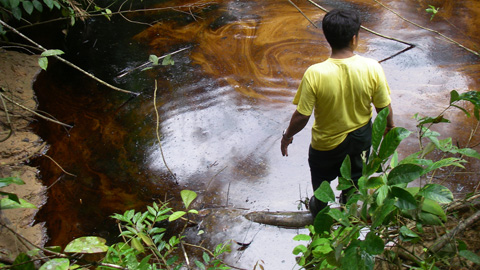High lead concentrations found in Amazonian wildlife

01/08/2019
It is in industrialised countries and regions of the world where one can find the highest concentrations of lead, the world's most widespread neurotoxical accumulative metal. Thus, it was presumed that the Amazon, the world's largest expanse of tropical rainforest containing the highest levels of biocultural and cultural diversity, would contain a low amount of urban or industrial contaminants due to its remoteness and low human impact.
A group of researchers from the Institute of Environmental Science and Technology and the Department of Animal Health and Anatomy at the Universitat Autònoma de Barcelona (ICTA-UAB), and the Central University of Catalonia/Vic University, for the first time have evaluated lead concentrations and isotopic fingerprints in free-ranging wildlife in remote areas of the Peruvian Amazon. For the study, liver samples were collected from 315 animals from 18 different species, hunted for food by local indigenous peoples (Quechua, Achuar and Yagua). These areas under study are very remote and only accessible after a 4-5 day boat trip along the local rivers. Some of these areas are also located within the second most productive oil concession of the country, operating since the 1970s.
High concentrations of lead were found in the livers of Amazon wild mammals and birds, animals which are consumed daily by the local indigenous population. These values are higher than those observed among wild animals found in industrialised countries. The presence of this unexpectedly high level of lead in Amazonian wildlife poses a health risk for the local population, which relies on subsistence hunting.
Half of all samples analysed contained more than the 0.5 miligrams per kilo which European regulation considers to be the limit for human consumption of animal entrails, and 91% contained more than the 0.1 miligrams considered a suitable level for human consumption of meat in general. A very high risk for the population, taking into account that almost thirty of the samples analysed contained far higher levels of lead.
The researchers also demonstrated that the main sources of lead are the extended use of lead-based ammunition, as well as pollution related to oil extraction. In fact, lead-based ammunition could be an underestimated problem throughout the continent of South America. These results suggest that lead has entered the trophic chain in areas where human population depends on subsistence hunting. Thus, it is not likely a unique problem, but one that affects indigenous people around the world who use lead-based ammunition.
In addition, the fact of having found oil-related lead in wildlife suggests that other toxic compounds related to oil activities may have also entered the trophic chain. Indeed, in the northern Peruvian Amazon, oil extraction activities have generated an important environmental impact through the daily spillage of lead-rich wastewater into the environment.
Due to the high dependence of indigenous people globally on subsistence hunting and the extended use of lead-based ammunition, jointly with the advance of oil activities in tropical rainforests (oil and gas reserves overlap with 30% of the world's rainforests), these results uncover an important health risk for tropical wildlife conservation and for local human communities depending on these animals as their main source of protein.
Finally, the study further illustrates how remote natural areas also contain yet another ubiquitous anthropogenic footprint. This might be extended throughout the Amazonian ecosystem and other rainforests around the world, illustrating how human impact reaches further than usually envisaged, and the expansion of anthropogenic contaminants from industrial centres to the most remote areas of the planet.
The study, published this week in the journal Nature Sustainability, included the involvement of Mar Cartró Sabaté, researcher at the Institute of Environmental Science and Technology at the Universitat Autònoma de Barcelona (ICTA-UAB); Pedro Mayor, Department of Animal Health and Anatomy at the UAB; Martí Orta, researcher at the Central University of Catalonia/Vic University and ICTA-UAB; and Antoni Rosell, ICREA researcher at the ICTA-UAB.
Original article:
Cartró-Sabaté, M., Mayor, P., Orta-Martínez, M., Rosell-Melé, A. Anthropogenic lead in Amazonian wildlife. Nature Sustainability. 2019. doi.org/10.1038/s41893-019-0338-7